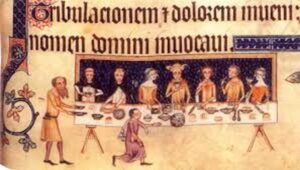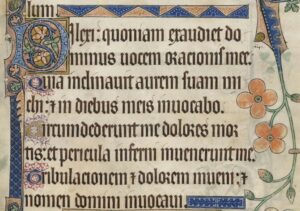The Luttrell Psalter: Knighthood, Hospitality and Piety / Geoffrey’s Feast
- Elaine Harrington
- January 17, 2019
Student Exhibition, MA in Medieval History
Geoffrey’s Feast
The image of Sir Geoffrey Luttrell appears for the second time in the Psalter on folio 208r, where he is shown seated at the splendid high table, in front of the wall tapestry covered with his heraldic martlets.

The accompanying text contains the opening verses of Psalm 114: Dilexi quoniam exaudiet Dominus vocem orationis meae, Quia inclinavit aurem suam mihi et in diebus meis invocabo te, Circumdederunt me dolores mortis pericula inferni invenerunt me tribulationem et dolorem inveni et nomen Domini invocavi / ‘I have loved, because the Lord will hear the voice of my prayer. Because he hath inclined his ear unto me: and in my days I will call upon him. The sorrows of death have encompassed me: and the perils of hell have found me. I met with trouble and sorrow: and I called upon the name of the Lord’ (Psalm 114:1-4).

Geoffrey is the central figure of the scene: he is positioned in the middle of the table with his family members all turning towards him. At the table are his wife, Agnes Sutton, seated on Geoffrey’s right hand side, followed by two Dominican friars, and on his left are two male figures and a woman, whose identities will be discussed below. Two servants wait on the guests. The table is laden with silverware and pewter utensils and a variety of foods. Diners in the miniature use spoons and knives, but no forks, and they drink from cups.
Come dine with me
The feast scene in the Luttrell Psalter gives us a glimpse into the structure of the manorial world of medieval England. Geoffrey and other members of the nobility enjoyed meat, wine and white bread. Bread loaves are placed in front of two male figures and a woman on Geoffrey’s left. The identity of one of the two men is debatable, one of them represents Andrew Luttrell, Geoffrey’s son who married Beatrice Le Scrope, who sits at the end of the table. The other male figure may be one of Geoffrey’s other sons, Geoffrey or Robert. Members of the Luttrell family held clerical posts in religious establishments in the areas that belonged to the family. We can see the Luttrell’s connection with the Church in the persons of the two friars attending the feast. They wear habits of the Dominican Order. These figures may represent Geoffrey’s chaplain, Robert Wilford, and his confessor, William Fotheringay. However, neither Robert nor William can be linked definitely to the Dominican Order. In the image, the friars take no meat; instead a bowl of eggs and bread is placed before them.
The feast in the lord’s manor was a display of the lord’s status but also of his hospitality and generosity that reflected his religiously motivated charity and social consciousness. Feasting also provided an opportunity to conduct business and discuss important matters, with religious and secular matters always being very close as seen in the presence of two Dominican friars at the Luttrell’s table.
Servants
On the lower margins of folio 207v, servants prepare the feast. Hens, capons and a suckling pig are being cut and placed on individual platters by a cook holding a large knife. On a smaller table a servant is pouring sauces into bowls. The presence of the suckling pig suggests this may be a Christmas feast at Irnham, as pigs were butchered at this time of year. The food is then carried ceremoniously across the page onto the high table by the three servants. A large retinue of servants was required for the upkeep of a house such as Irnham. One of the servants on folio 208r has a purse attached to his belt, which suggests his higher position. On the same folio, a kneeling cup-bearer waits on Geoffrey.

Geoffrey’s Feast and the Last Supper
The cup-bearer wears a white scarf with black patters resembling a Jewish prayer stole and creates a visual link between Geoffrey’s feasts and the Last Supper on folio 90v. In the Last Supper the table at which Christ sits with his Apostles is covered with a cloth that has a pattern similar to the cup-bearer’s scarf. Further allusions to the Last Supper in Geoffrey’s feast can be seen in a sizeable silver plate which is placed in the middle of the table. It is marked with a cross shape resembling a Eucharistic host. Geoffrey’s raised cup alludes to the cup raised by Christ at the Last Supper as recounted in the Gospels (Matthew 26:26-28, Mark 14:22-24, Luke 22: 19-20). It also alludes to Psalm 115:3 that reads: Calicem salutaris accipiam et nomen domini invocabo / ‘I will take the chalice of salvation; and I will call upon the name of the Lord’, the text of which is copied on folio 209r. Visual references to the Last Supper in the image of a secular feast emphasise the significance of communal meals and the sacred nature of sharing food.
Patrick James O’Dwyer
Bibliography
Backhouse, Janet, Medieval Rural Life in the Luttrell Psalter, Toronto: University of Toronto Press, 2000.
Bothwell, James, Goldberg, P. J. P. and Ormrod, M.W., The Problem of Labour in Fourteenth-Century England, Woodbridge: Boydell & Brewer, 2000.
Camille, Michael, Mirror in Parchment: The Luttrell Psalter and the Making of Medieval England, London: Reaktion Books, 2013.
Cullum, H. P., Lewis, J. Katherine, Religious Men and Masculine Identity in the Middle Ages, Woodbridge: The Boydell Press, 2013.
Normore, Christina, A Feast for the Eyes: Art Performance, and the Late Medieval Banquet, Chicago: University of Chicago Press, 2015.
Staffin, Ross, The Culture of Food and Feasting in High Medieval England, c.1066-1330, M Phil Thesis, University of Exeter, 2016, (accessed 14.12.2018).
Woolgar, Christopher M., The Culture of Food in England, 1200-1500, New Haven and London: Yale University Press, 2016.
